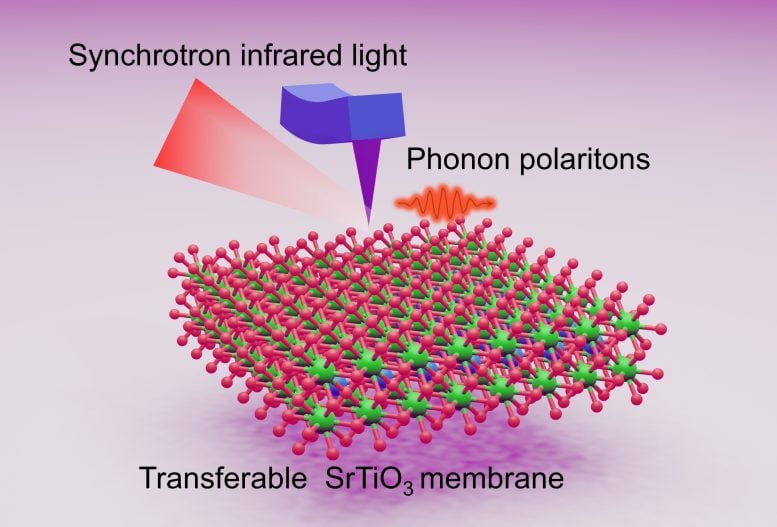

Left: The device consists of a 2D semiconductor between two mirrors, the polariton in purple and the dark excitons in red or blue depending on the spin. The effect of dark excitons can be encapsulated in the polaron, the dashed white circle. Right: The resulting transmission spectrum. Credit: FLEET
A team of Monash researchers have revealed for the first time the full effects of interactions between exciton-polaritons and their dark excitonic reservoir. The study, “Polaronic Polariton Quasiparticles in a Dark Excitonic Environment,” was published in Physical review B.
Exciton-polaritons (polaritons, for short) are hybrid mixtures of light and matter that inherit the best properties of both. They are formed on semiconductors sandwiched between two mirrors, through which a laser shines.
“Polaritons capture useful properties of matter and light,” says lead author Kenneth Choo. “Their ‘matter’ part means we can manipulate them through their interactions. Meanwhile, the ‘light’ part makes the polariton almost massless, resulting in the formation of a superfluid condensate that flows effortlessly.
“Put them together and it forms a new type of ‘liquid light’ that we can direct and control, potentially the basis for the next generation of computing that uses light to build circuits,” says Kenneth, who is a Ph.D. . candidate at Monash.
But with every yang there is a yin, and so it is with the polariton’s dark counterpart – a dark exciton.
These dark excitations are uncoupled from light but still able to interact with polaritons.
“Whenever polaritons are formed in experiments, they tend to be accompanied by a significant reservoir of these dark exciters that are formed along with them. The fact that they are dark, however, means that it has been difficult to see the effect their real self,” he says. corresponding author Prof Meera Parish.
A famous technique is worn for this occasion
The Monash researchers used a framework known as liquid Fermi theory to explain the dark reservoir effect on bright polaritons. The core idea is to map the (many, many) possible interactions into a new ‘quasiparticle’—one with a different mass, energy, and lifetime to the original. This allows the multi-particle system to be treated as if it were a single particle.
One such quasiparticle is the polaron, which can be thought of as a ‘zone of influence’ around the original particle.
Using this technique and including all possible two-particle interactions, they discovered that the bright polariton is “dressed” by excitations of the dark medium, forming a new quasiparticle called the polaron polariton.
Physically, this manifests as a reduction in the light-matter coupling strength as the dark exciton density increases, an effect commonly seen in experiment.
In contrast, the strength of the interactions between the dark reservoir and the polaritons increases, especially when the spins of the reservoir and the polariton are different. This effect can be strong enough to create an additional quasi-particle—the biexciton polariton—which is associated with the bound state of two excitons with opposite spin.
This phenomenon, known as a Feshbach resonance, was first observed in ultracold atomic gases and offers the promise of being able to tune the interaction strength to whatever value you want. It would then be possible to create reservoir “hills” and “valleys” that guide the flow of polariton condensate and then change them by moving a switch (laser).
What is expected next?
This study opens up new possibilities in the field of reservoir engineering. Already, there has been experimental progress in using this dark reservoir to trap and focus bright polaritons, and the study shows how the reservoir can be used to fundamentally change the polaritons themselves.
In addition, this study offers a new way to look at the old results – by accounting for the hitherto unknown influence of the reservoir, a more accurate determination of the interaction strengths can be obtained.
More information:
Kenneth Choo et al, Polaronic Polariton Quasiparticles in a Dark Excitonic Environment, Physical review B (2024). DOI: 10.1103/PhysRevB.109.195432. ACTIvE arXiv: DOI: 10.48550/arxiv.2312.00985
citation: Dark excitons shed new light on matter (2024, June 12) Retrieved June 13, 2024 from https://phys.org/news/2024-06-dark-excitons.html
This document is subject to copyright. Except for any fair agreement for study or private research purposes, no part may be reproduced without written permission. The content is provided for informational purposes only.
#Dark #excitations #shed #light #matter
Image Source : phys.org



